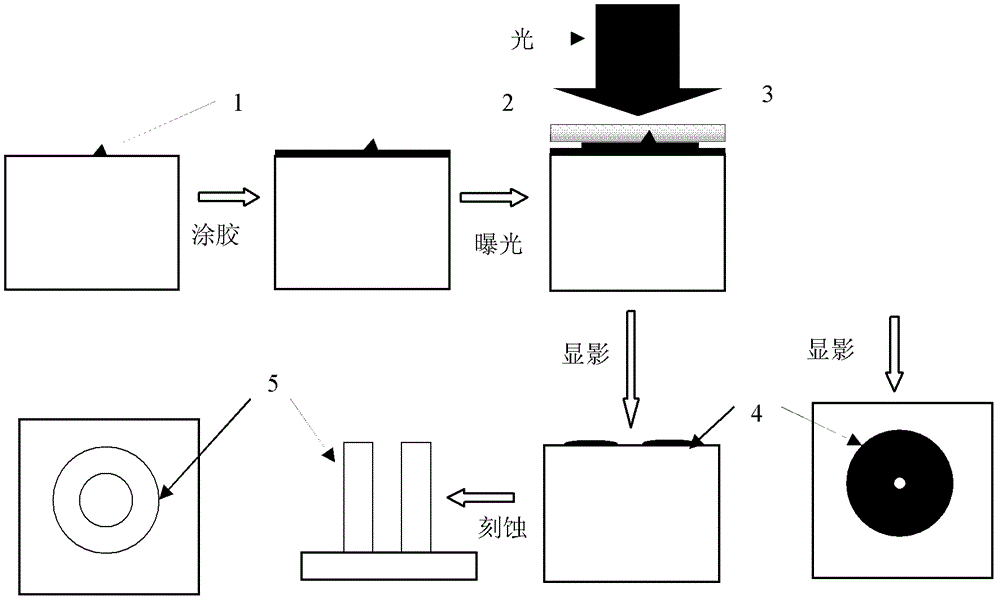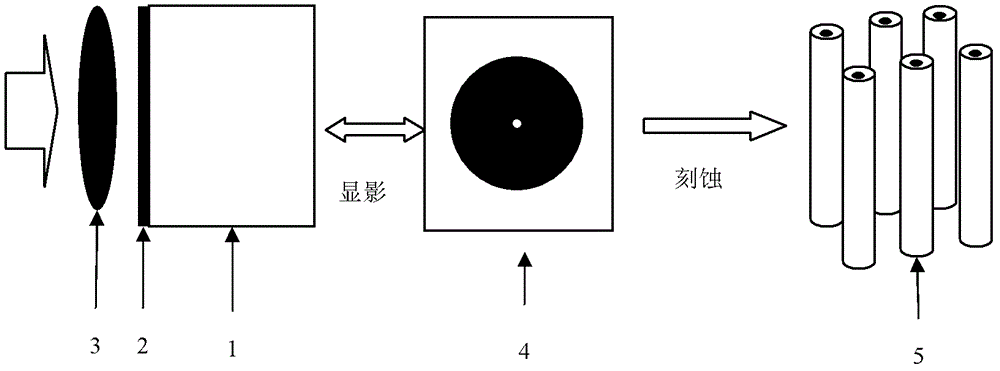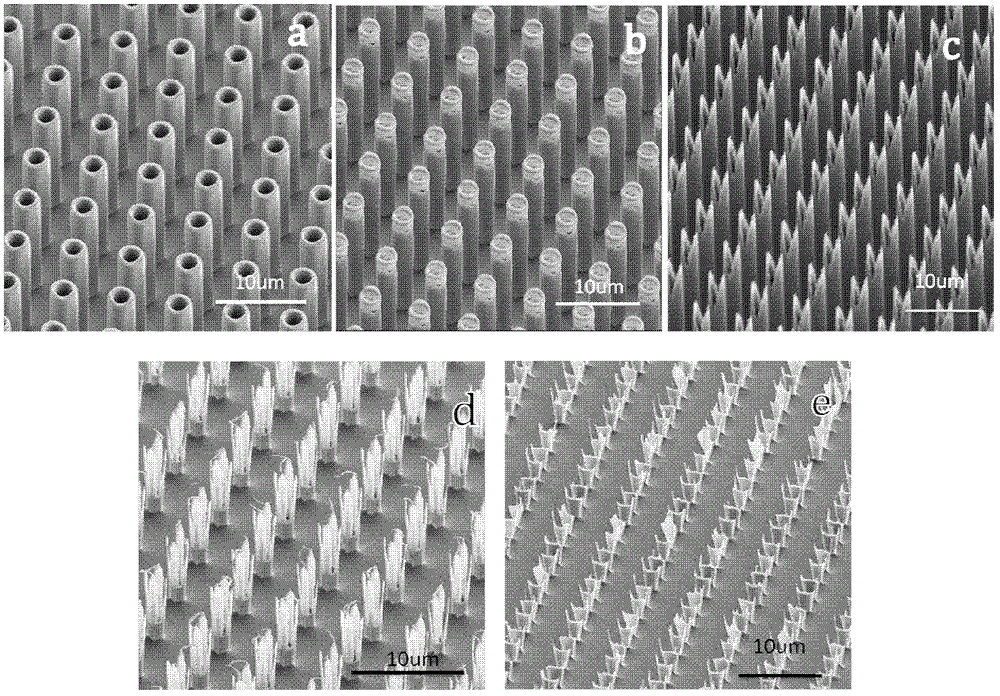Optical exposing method, and method for applying optical exposure in preparation of silicon material vertical hollow structure
A silicon material, hollow technology, applied in the direction of microlithography exposure equipment, photosensitive material processing, manufacturing microstructure devices, etc., can solve the problems of expensive, difficult to use, high cost, etc., and achieve low production cost, simple operation and repeatability Good results
- Summary
- Abstract
- Description
- Claims
- Application Information
AI Technical Summary
Problems solved by technology
Method used
Image
Examples
example 1
[0057] For the silicon tubular array structure prepared in this example, please refer to the attached image 3 (a), the silicon tube wall thickness is 200 nanometers, the inner diameter is 300 nanometers, and the height is 20 microns, and its specific preparation method is as follows:
[0058] 1) Silicon wafer surface treatment: take a piece of silicon substrate 1, adopt the conventional semiconductor cleaning process, that is, ultrasonically clean it in acetone, alcohol and deionized water in sequence, and dry it with nitrogen;
[0059] 2) Coating: Spin-coat S1813 photoresist 2 on the silicon substrate 1, and control the spin-coating speed to obtain a photoresist coating with a thickness of 500 nanometers;
[0060] 3) Pre-baking: baking the photoresist-coated silicon wafer obtained in step 2) on a hot plate at 150° C. for 0.5 minutes;
[0061] 4) Exposure: select the mask plate 3 with a solid circle array pattern with a radius of 1 micron. Expose on the MA6 UV exposure mach...
example 2
[0065] For the silicon tubular array structure prepared in this example, please refer to the attached image 3 (b), the silicon tube wall thickness is 100 nanometers, the internal diameter is 350 nanometers, and the height is 20 microns, and its specific preparation method is as follows:
[0066] 1) Silicon wafer surface treatment: take a piece of silicon substrate 1, adopt the conventional semiconductor cleaning process, that is, ultrasonically clean it in acetone, alcohol and deionized water in sequence, and dry it with nitrogen;
[0067] 2) Coating: Spin-coat S1813 photoresist 2 on the silicon substrate 1, and control the spin-coating speed to obtain a photoresist coating with a thickness of 800 nanometers;
[0068] 3) Pre-baking: baking the photoresist-coated silicon wafer obtained in step 2) on a hot plate at 115° C. for 1 minute;
[0069] 4) Exposure: select the mask plate 3 with a solid circle array pattern with a radius of 1 micron. Expose on the MA6 UV exposure mach...
example 3
[0073] For the V-shaped tubular array structure of this example, please refer to the attached image 3 (c), the prepared silicon tube wall thickness is 100 nanometers, the internal diameter is 350 nanometers, and the height is 30 microns, and its specific preparation method is as follows:
[0074] 1) Silicon wafer surface treatment: take a piece of silicon substrate 1, adopt the conventional semiconductor cleaning process, that is, ultrasonically clean it in acetone, alcohol and deionized water in sequence, and dry it with nitrogen;
[0075] 2) Coating: Spin-coat S1813 photoresist 2 on the silicon substrate 1, and control the spin-coating speed to obtain a photoresist coating with a thickness of 800 nanometers;
[0076] 3) Pre-baking: baking the photoresist-coated silicon wafer obtained in step 2) on a hot plate at 115° C. for 1 minute;
[0077] 4) Exposure: select the mask plate 3 with a solid circle array pattern with a radius of 1 micron, and expose it on the MA6 type ultr...
PUM
| Property | Measurement | Unit |
|---|---|---|
| radius | aaaaa | aaaaa |
| height | aaaaa | aaaaa |
| thickness | aaaaa | aaaaa |
Abstract
Description
Claims
Application Information
 Login to View More
Login to View More - R&D
- Intellectual Property
- Life Sciences
- Materials
- Tech Scout
- Unparalleled Data Quality
- Higher Quality Content
- 60% Fewer Hallucinations
Browse by: Latest US Patents, China's latest patents, Technical Efficacy Thesaurus, Application Domain, Technology Topic, Popular Technical Reports.
© 2025 PatSnap. All rights reserved.Legal|Privacy policy|Modern Slavery Act Transparency Statement|Sitemap|About US| Contact US: help@patsnap.com



